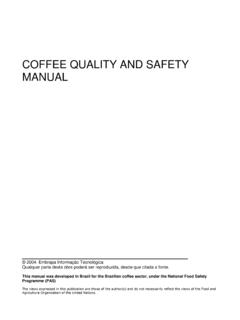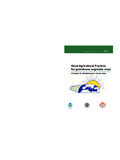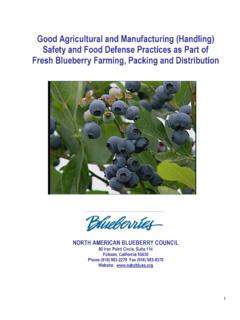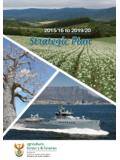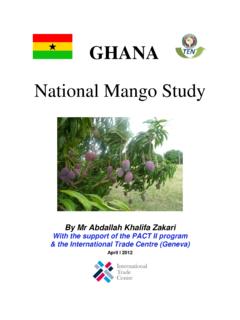Transcription of A Guide to Good Agricultural Practices (GAP) for …
1 A Guide to good Agricultural Practices (GAP) for Crop Production This booklet was funded by the Ministry of Agriculture and Fisheries, Jamaica;. June 2012. Published by the Ministry of Agriculture and Fisheries Hope Gardens, Kingston 6. 2012, June 2012 by the Ministry of Agriculture and Fisheries All rights reserved No part of this document may be reproduced or transmitted in any form or by any means electronic or mechanical including photocopying, recording or using any information storage retrieval system-without permission in writing from the publisher. First edition 2012, June ACKNOWLEDGEMENTS. The good Agricultural Practices (GAP) manual for crops is a set of guidelines aimed at promoting best Practices in crop production. Its principal aim is to minimize the risk of contamination of foods by bacteria and other microbial pathogens, pests and chemicals during the primary production activities. The compilation of this manual is the result of the collective efforts of several people.
2 Thanks to Dr Richard Harrison, Don McGlashan and Claudette McKenzie for their foresight and vision in seeing the need for farmers to have relevant easy-to-understand information at their fingertips. Special thanks to Joseph Lindsay, PhD; T. Burton; Winston Simpson and Francine Webb of the Rural Agricultural Development Authority for their technical contribution in preparing the manual. And for the vital technical given during the early stages of the manual, sincere gratitude is extended to Carol Thomas, the Inter-American Institute for Cooperation on Agriculture's regional Agricultural health and food-safety specialist for the Caribbean. And to Permanent Secretary Donovan Stanberry, whose unstinting encouragement and support spurred the growth of the manual, many thanks. Thanks also to Tehuti Ra for graphic design and layout and Andrea Hoo Fung for copy-editing of the manual. Funding for the publication of this manual was provided by the Ministry of Agriculture and Fisheries, Jamaica.
3 Don McGlashan Director General Ministry of Agriculture & Fisheries ACRONYMS. COLEACP - Europe-Africa-Caribbean-Pacific Liaison Committee FIFO - First in, first out GAPs - good Agricultural Practices SSOP - Sanitation Standard Operating Procedures Contents ACKNOWLEDGEMENT. ACRONYMS. INTRODUCTION 1. OBJECTIVES 2. SCOPE 2. PLANTING MATERIAL 3. SITE SELECTION/MANAGEMENT 3. LAND PREPARATION 4. SOIL MANAGEMENT 5. WATER MANAGEMENT 5. IRRIGATION/FERTIGATION 5. FERTILIZER USAGE 6. FERTILIZER STORAGE 6. ORGANIC FERTILIZER/MANURE 7. CROP MANAGEMENT 7. CROP PROTECTION (Pesticides Usage) 8. Field Application 8. Pesticide Storage 10. Transportation of Pesticides 11. Disposal of Pesticides (containers and surplus) 11. Training and Worker Safety 12. Documentation of Pesticide Application 13. HARVESTING 13. POST-HARVEST HANDLING/TREATMENT 14. FIELD SANITATION 15. EQUIPMENT AND MACHINERY 15. TRANSPORTATION 16. STORAGE 17. WASTE DISPOSAL 18. TRACEABILITY AND RECORD KEEPING 19.
4 EMPLOYEE HEALTH, WELFARE AND SAFETY 20. SANITARY FACILITIES 21. BUILDINGS 22. REFERENCES 24. GLOSSARY 25. A Guide to good Agricultural Practices (GAP) for Crop Production INTRODUCTION. P. eople are becoming increasingly conscious of what they consume and are, therefore, demanding safer, more wholesome foods. Additionally, the proven health benefits of fresh fruits and vegetables to cancer and heart disease prevention have resulted in increased consumption of these commodities. Further, with the expansion of global trade and travel, consumption of these produce has increased due to year-round availability. However, in recent times, there have been increased reports of food-borne illnesses associated with fruit and vegetable consumption, and this has raised concerns by consumers about the systems used in the production chain in relation to hygiene and the environment. Food should be produced under conditions that minimize contamination, as food-borne.
5 Fresh fruits and vegetables illnesses can be fatal and repeated have been proven to provide incidences are likely to be damaging health benefits to cancer and to international trade (exports/ heart disease patients and this has resulted in increased imports), tourism and production, thus consumption of these leading to loss of income and commodities. employment. As such, we all have a responsibility to ensure that food is safe for consumption. With this in Ministry of Agriculture and Fisheries GAP Manual 1. A Guide to good Agricultural Practices (GAP) for Crop Production mind, good Agricultural Practices (GAP) must be employed throughout all the stages of production. OBJECTIVES. This document sets out guidelines for good Agricultural Practices (GAP). from site selection to post-harvest handling. It outlines the steps necessary to assist in reducing and controlling hazards (biological, chemical and physical) associated with crop production, from pre- planting to transportation and storage.
6 The principles outlined are in no way exhaustive and do not apply to any This document sets out specific crop. While it might be guidelines for good difficult to adopt all due to the Agricultural Practices (GAP). structure of the Agricultural sector, they must be regarded as general recommendations to be used in food production and handling. SCOPE. The principles in this document apply to the production and handling of fresh horticultural produce fruits, vegetables, herbs, root crops etc., but are not applicable to manufactured foods. These guidelines are applicable to both local and export markets and cover the production These guidelines are chain from the farm to market that applicable to both local and is, from production through to export markets and cover the transportation and storage. The production chain from the farm document does not apply to domestic to market. 2 Ministry of Agriculture and Fisheries GAP Manual A Guide to good Agricultural Practices (GAP) for Crop Production handling Practices or to the food- service industry.
7 PLANTING MATERIAL. Seeds/planting material must be free from pests and diseases. Seed records must be kept to indicate variety, purity, Seeds/planting material must germination, batch number, seed be free from pest and supplier and country of origin. diseases. All seed treatment (products). applied should be recorded, together with the pests/diseases targeted. Seeds must be handled carefully to avoid contamination. Planting material must be stored according to the manufacturers'. instructions in order to prevent damage or contamination. SITE SELECTION/. MANAGEMENT. Land for crop production should be selected based on previous land usage/history/capability/. suitability. Seeds must be handled Test sites for contaminant(s) if carefully to avoid land history is unavailable/ contamination unknown. Check sites for potential biological/chemical/physical hazards. Ministry of Agriculture and Fisheries GAP Manual 3. A Guide to good Agricultural Practices (GAP) for Crop Production Crop production activities should be located at a suitable distance from livestock operations to avoid animal contamination.
8 Fields should not be sited near feedlots or points where animal waste can contaminate them. Run-off/contaminated water should not be allowed to enter fields. Map out production areas (field/orchard/greenhouse) prior to planting. Prepare land, using techniques to improve/. maintain soil structure and to LAND PREPARATION avoid compaction. Soil must be properly tilled and weathered before planting. Avoid overtillage. Prepare land using techniques to improve/maintain soil structure and to avoid compaction. Avoid mechanical land preparation on slopes above 20. degrees. Use equipment appropriate to soil type and moisture content. Mechanical land preparation Mechanical land preparation should be done on land where it should be done on land where will improve/maintain soil it will improve/maintain soil structure. structure. 4 Ministry of Agriculture and Fisheries GAP Manual A Guide to good Agricultural Practices (GAP) for Crop Production SOIL MANAGENMENT.
9 Prepare soil maps prior to planting. Soil conservation measures, such as contouring, cover cropping, mulching etc, should be Pineapple barriers employed to prevent erosion and soil degradation. Soil type should be appropriate for the crops being grown. Only properly composted/aged manure must be used in fields. Manure should be incorporated Contouring planting into the soil before planting. WATER MANAGEMENT. Put water-conservation methods (dams, tanks) in place before planting. Records of water consumption must be kept. Use water-saving irrigation Gravity drip irrigation system methods, drip, micro- sprinkling. IRRIGATION/ FERTIGATION. Identify water source before planting. The irrigation water source should be protected from animals and other sources of contamination. Sprinkler irrigation system Ministry of Agriculture and Fisheries GAP Manual 5. A Guide to good Agricultural Practices (GAP) for Crop Production Water used for fertigation/.
10 Pesticide application should be free of pathogens/contaminants. Water used for foliar treatments (fertilizers, pesticides, etc.) must be of post-harvest quality. Use the appropriate type and quantity of fertilizer. Water should be tested twice per year for possible contaminants (microbial, chemical, heavy metals). FERTILIZER USAGE. Use the appropriate type and quantity of fertilizer (based on soil analysis). All fertilizer applications must be Apply fertilizer economically' to recorded according to field/ avoid spillage and waste. orchard map. Machinery used for fertilizer application should be kept in good working condition (maintenance schedule/. calibration). Methods of fertilizer application (mechanical/fertigation/manual). should be recorded. Apply fertilizer economically' to avoid spillage and waste. FERTILIZER STORAGE Store fertilizer in a covered Store fertilizer in a covered area area that is clean, dry and at least 10cm off the ground.

